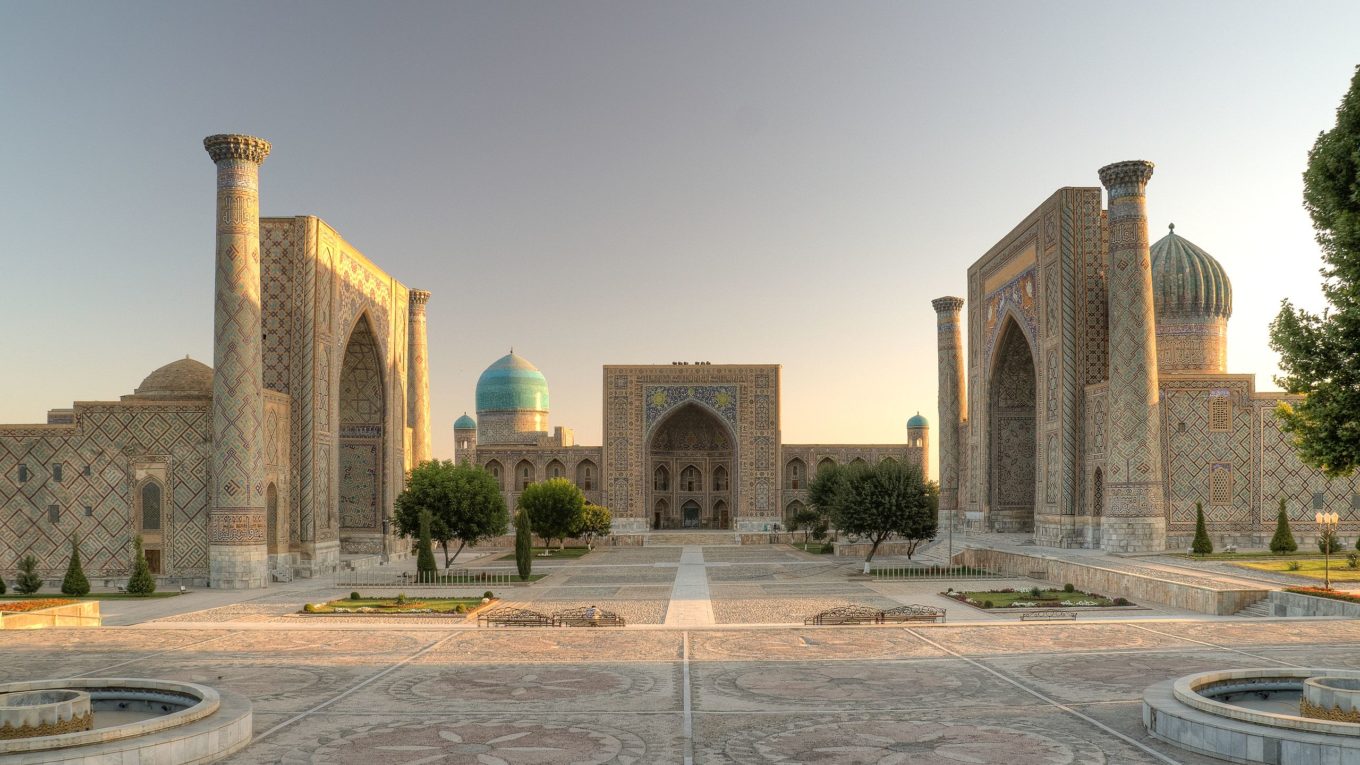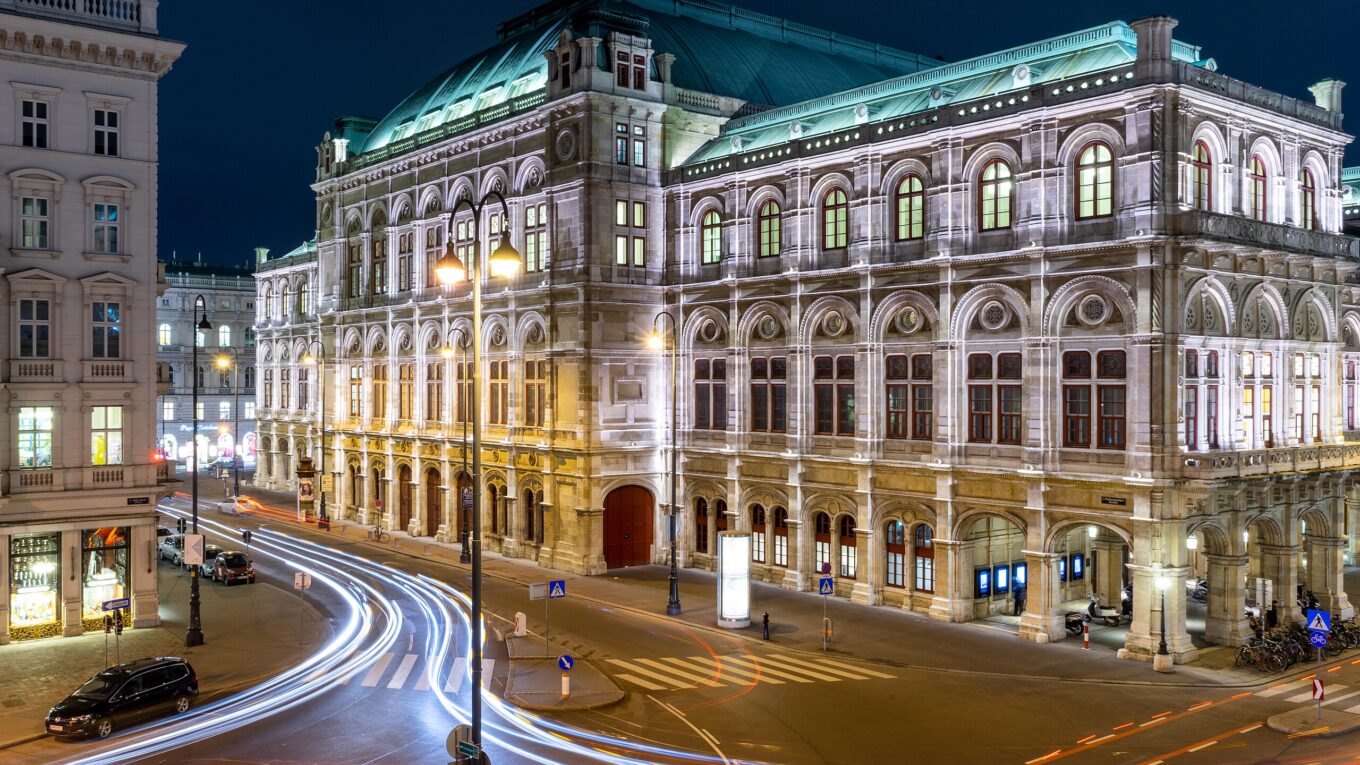Timurid Architecture and the Timurid Renaissance
Timur, also known as Timurlane or Tamerlane, was one of the greatest conquerors the world has ever known. He controlled a massive domain that stretched across Central Asia, encompassing parts of modern-day, Turkey, Iran, Uzbekistan, Afghanistan, Pakistan, and India. Timur founded a dynasty that would rule the Timurid Empire for over 130 years. Timur and his descendants were devout Muslims, and they helped spread the influence of Islam throughout Central Asia.
At its cultural zenith, the empire started by Timur entered a long period of prosperity, and many incredible works of art and architecture were completed. Great advances were also made in fields like astronomy and mathematics, which is why many historians refer to this period as the Timurid Renaissance. This article will highlight some of the greatest examples of Timurid Architecture and show just how influential the Timurid Renaissance was to the development of Central Asia.
Who was Timur?
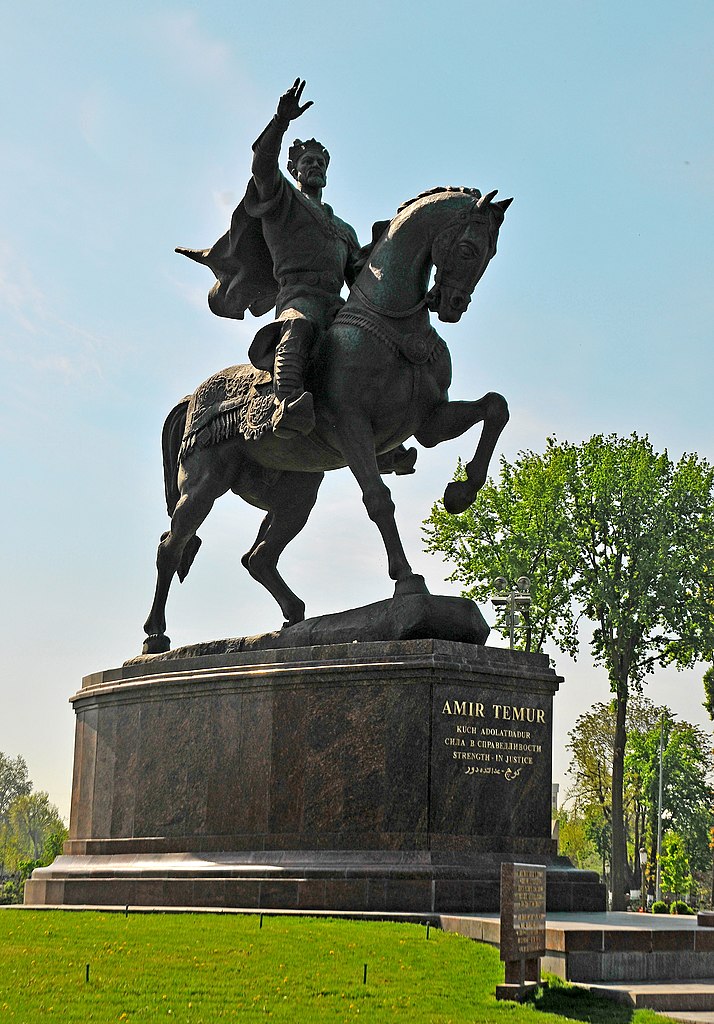
Timur was a Turko-Mongol conqueror who was born in the year 1336. He claimed to be a direct descendant of the great Genghis Khan. (although most warlords living in this part of Asia also made this same claim)
Timur famously sustained a leg injury at a young age, which lead to him having a limp when he walked. This earned him the nickname Timur the Lame, which was eventually abbreviated to Timurlane or sometimes Tamerlane.
Timur won countless battles and skirmishes throughout his military career, which has earned him a position among the list of the world’s greatest conquerors. Although Timur’s empire never matched the size of the older Mongolian Empire, it still proved to be one of the most significant Turco-Mongol Nations to have ever existed.
History of the Timurid Empire
Timur established his great empire in the heart of Central Asia, after a series of conquests beginning in 1370 when he was just 34. Through several major military victories, Timur was able to control an area of over 2.1 million square miles, creating a nation that stretched from modern-day Turkey in the East, all the way to India in the West. The Timurid Empire would officially last from 1370 to 1507, after which most of its territory was seized by various other factions, including the Safavid Persians.
The dashed lines indicate the reconsolidated borders of the empire after the death of Timur – most Timurid Architecture is concentrated within this zone which was held by the empire from about 1410 onward.
Timur’s descendants ruled as part of the Timurid Dynasty. Two of the most important Emperors were Shah Rukh and Ulugh Beg, both known as men of science and academics. They helped finance the work of local intellectuals and scholars, which lead to great advances in the fields of Mathematics, Philosophy, Astronomy, and Physics. Although the Timurid Empire eventually fell in 1507, a distant descendent of Timur named Babur, would eventually go on to found the Mughal Empire. The Mughals ruled over much of modern-day India and Pakistan, and they went on to create some of the world’s most well-known buildings such as the Taj Mahal.
Timurid Architecture Characteristics
Monumental Entrances
Photo by Teo Romera from flickr
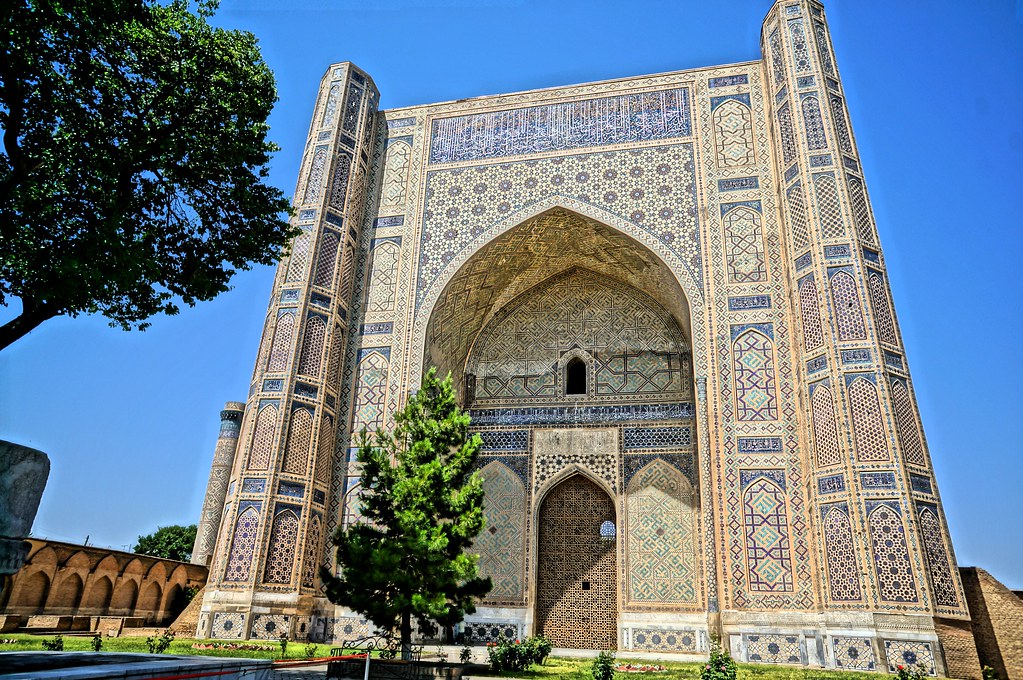
The architecture of the Timurid Empire is often bold, impressive, and awe-inspiring. Just about all of the major building projects contain some sort of Monumental Entrance – a massive facade and archway at the main doorway of a building. Here at the Bibi-Khanym Mosque in Samarkand, there are not one but two massive entrances. The above image is of the second facade, which stands 330 feet (100 m) behind the first facade.
Islamic Calligraphy and Geometric Patterns
Photo by Vuriy75 from Wikimedia Commons
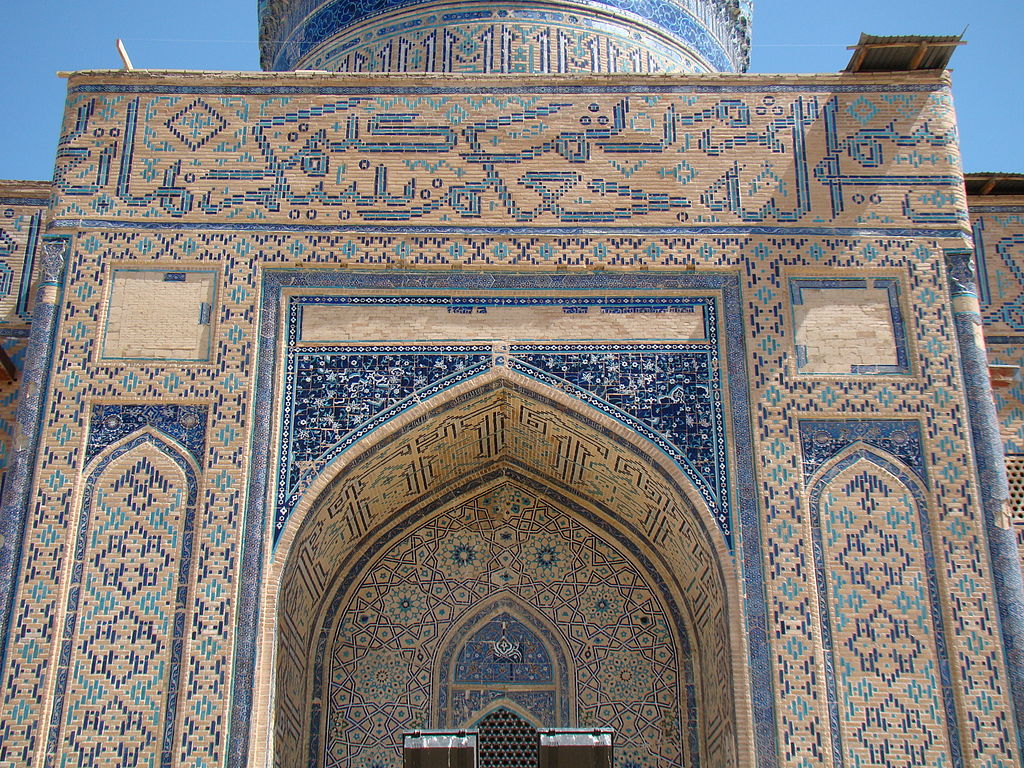
Like nearly all other forms of Islamic Architecture, the Architecture of the Timurid Empire is highly decorated with geometric patterns and Islamic Calligraphy. Traditionally in Islam, it is forbidden to create images of people, places, animals, or nature. So instead most buildings in the Muslim World are decorated with shapes, patterns, and text. Here at the Mausoleum of Khoja Ahmed Yasawi in modern-day Kazakhstan, you can see the front facade is decorated with a combination of geometry and calligraphy.
Blue Tilework
Photo by Faqsci from Wikimedia Commons

Just about every major building in the Timurid Empire was built using the same color scheme. This mixture of dark, and light blues is found throughout Central Asia, and it can also be found in many great examples of Iranian Architecture. The image above shows some of the surviving tilework at the Summar Palace of Timur. The palace was built by Timur himself in the town where he was born, Shahrisabz in modern-day Uzbekistan. Construction on the massive palace began in 1380, which shows you that Timurid Architecture featured this same blue color scheme from the very beginning of the empire.
Domes
Photo by LBM1948 from Wikimedia Commons
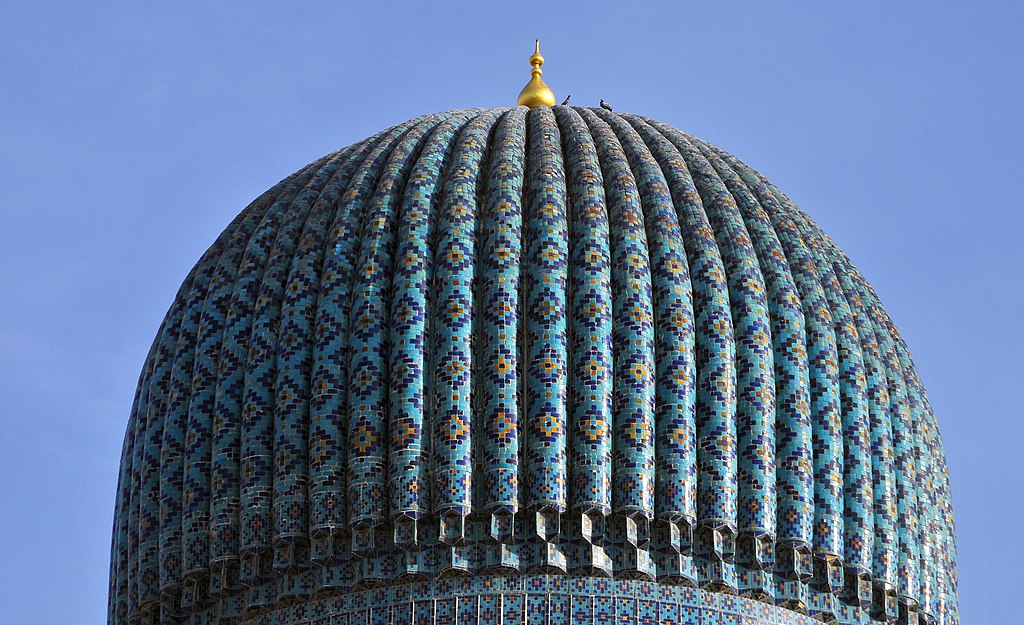
Another element that is found throughout Timurid Architecture, is the Dome. Domes can be found in many different types of buildings such as mosques, mausoleums, and madrasas. There are a few different varieties of domes that were popular, one of them being the bulbous dome. A bulbous dome, like the one here at Timur’s Mausoleum in Samarkand, is unique because the middle of the dome is the widest part and has a larger circumference than the base of the dome. This was a technological innovation that was becoming very popular in Central Asia during this time, and bulbous domes can be found throughout the architecture of Uzbekistan, Afghanistan, Pakistan, India, and Iran among others.
Elements from Islamic Architecture
Photo by Marius Arnesen from Wikimedia Commons
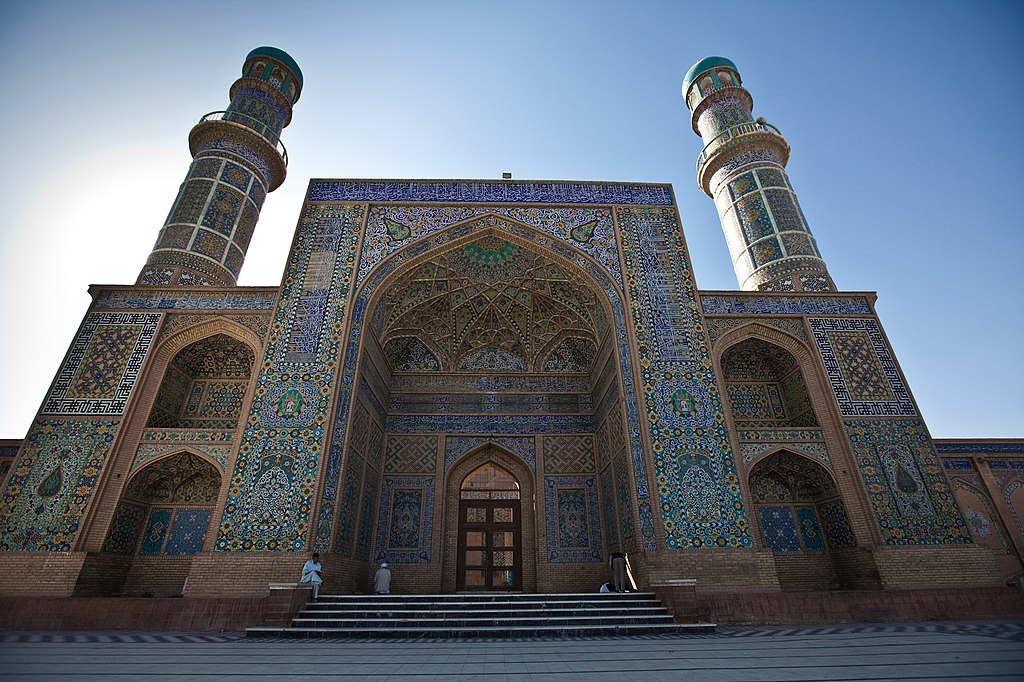
The architecture of the Timurid Empire also contains many of the unifying characteristics found throughout all Islamic Architecture. Courtyards, Minarets, pointed arches and Muqarnas are all examples of these Islamic motifs. The image above shows one of the main entrances to the Great Mosque of Herat, located in modern-day Afghanistan. Here you can see all of the typical elements of Islamic Architecture, such as the two Minarets at either side of the Monumental Arch, as well as the ornately carved Muqarnas above the central doorway.
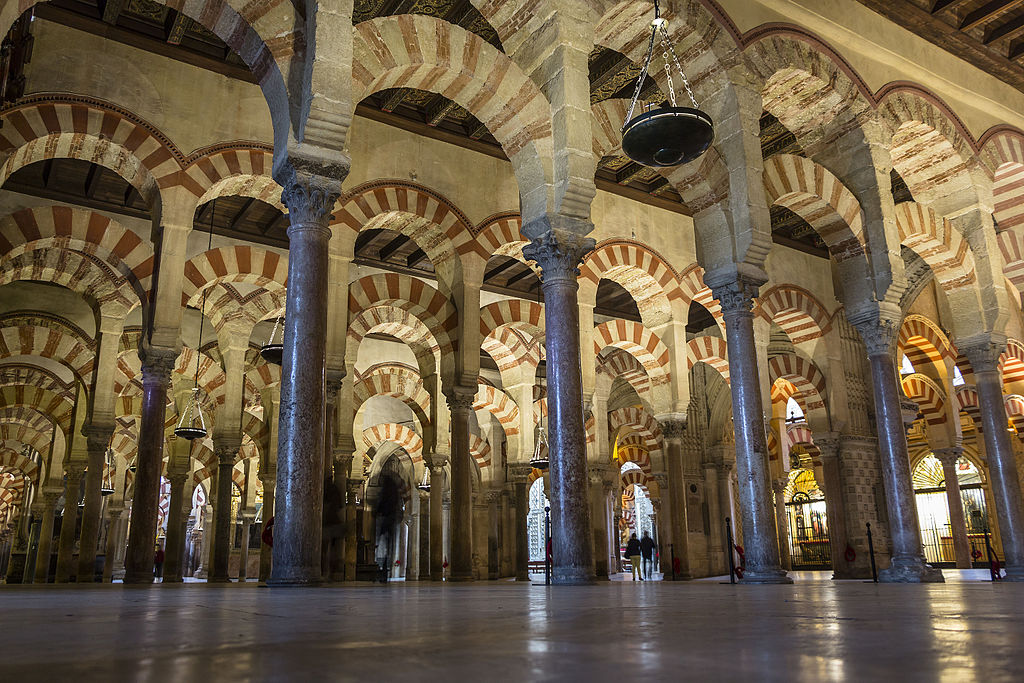
Interested in Islamic Architecture? Check out our article on the Moorish Architecture of Spain to learn more!
What are the best examples of Timurid Architecture?
Timur created a massive empire, that controlled much of Central Asia. The Timurid Empire borrowed heavily from older civilizations such as the Persians, and the Arabs, and they created some of the most incredible buildings that can be found throughout the region. This list will attempt to showcase some of the finest, most innovative, and most impressive examples of Timurid Architecture; highlighting various buildings from throughout the former lands of the Timurid Empire.
1. Registan of Samarkand – Samarkand, Uzbekistan

Without a doubt, the single greatest example of Timurid Architecture is, of course, the Registan of Samarkand. The Registan is made up of three distinct buildings, The Ulugh Beg Madrasah, and Sher-Dor Madrasah, and the Tilya-Kori Madrasa. Madrasa is an Arabic word meaning school, and the three madrasas of the Registan were each founded for education, teaching some of the various topics that were popular in the Timurid Renaissance such as Astrology, Mathematics, and Religious Studies. You can check out this Photo Sphere to get a sense of the layout of the Registan.
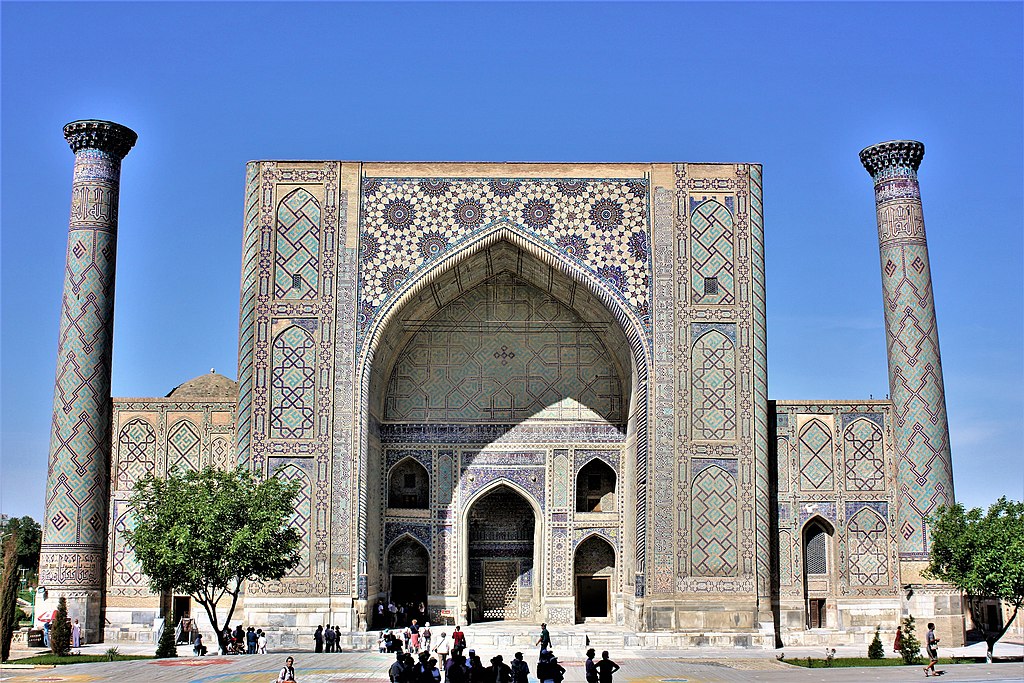
The Ulugh Beg Madrasah (depicted above) was built from 1417-1420. Construction began 12 years after the death of Timur, during the reign of Ulugh Beg, one of Timur’s successors. The Madrasa was constructed in the early stages of the Timurid Renaissance, but you can still see all of the key elements of Timurid Architecture. The multi-colored-blue tiles can be found throughout the exterior, and the monumental entrance and main facade are ornately decorated with geometric patterns.
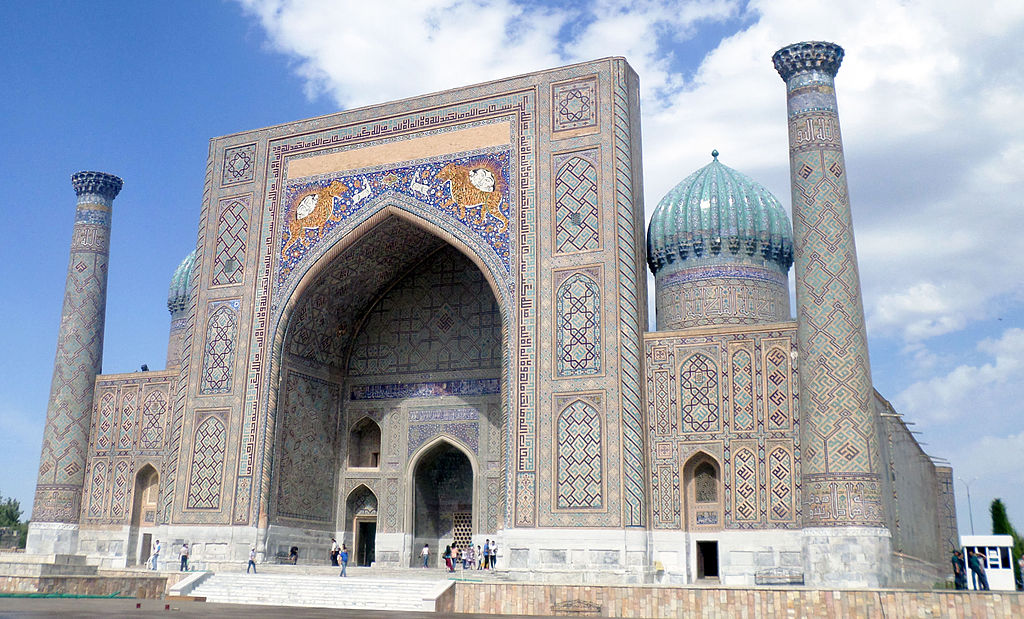
Located directly across the square from the Ulugh Beg Madrasa, the Sher-Dor Madrasah was built much later on, beginning in 1619 and ending in 1636. Although this was at the tail end of the Timurid Renaissance, you can still see many of the same characteristics. Although this newer building is known for the two domes and the bright orange tiger mosaics above the main entrance, it still has a cohesive appearance with all of the older monuments found throughout Samarkand. Thanks in large part to all of the Timurid-Style Architecture found in the city, Samarkand has a very cohesive appearance with much of the buildings borrowing the same elements from the original structures built during the reign of the great Timur.
2. Mausoleum of Khoja Ahmed Yasawi – Turkestan, Kazakhstan
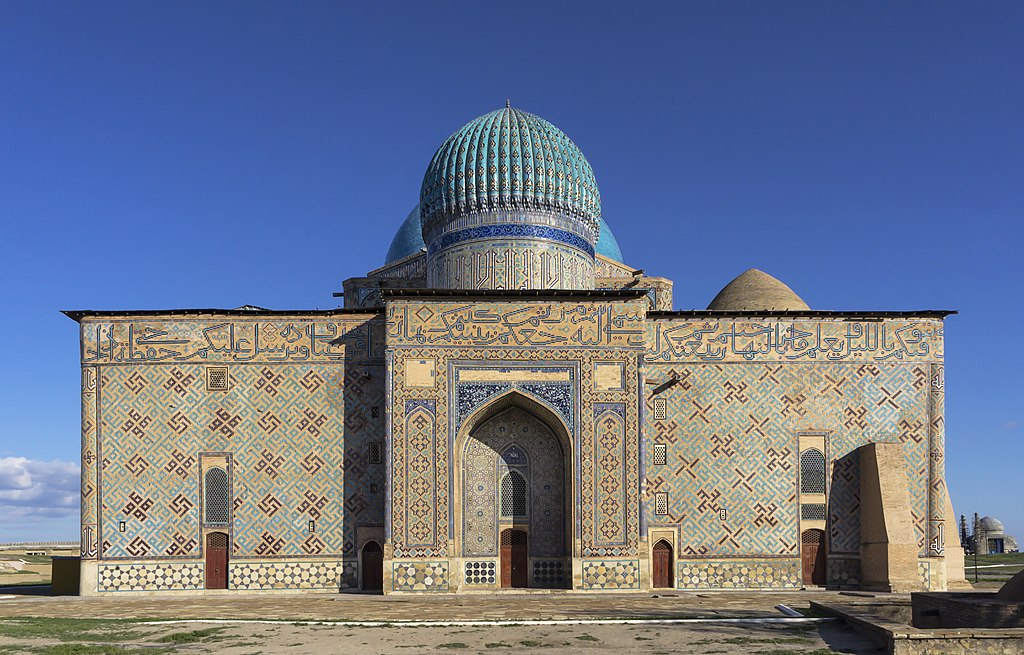
In the year 1389, Timur commissioned the construction of a massive mausoleum dedicated to the Turkic poet, Khoja Ahmed Yasawi. There had been an existing mausoleum on the site since the 12th century, but Timur wanted to build a much larger and grander edifice to honor the poet. The mausoleum had several different entrances, the back (depicted above) is less monumental, but this side was completed during the time of Timur and it is festooned with typical Timurid-Style blue tilework.

The Main Monumental Entrance to the building was never completed. Timur died in the year 1405, and with him died the spirit to build such a grand structure. You have to use your imagination, but one can easily see how impressive this structure would have been, had it been completed. Despite never being finished, the Mausoleum of Khoja Ahmed Yasawi remains particularly well preserved and is currently listed as a UNESCO World Heritage Site.
3. Bibi-Khanym Mosque – Samarkand, Uzbekistan

The Bibi-Khanym Mosque is another incredible monument built by the Timurid Empire within Samarkand. Samarkand was the original capital of the empire, starting in 1370 until the capital was moved to Herat in 1405. Samarkand is known as an oasis, a large patch of lush green amongst an arid wasteland. Many traders stopped in Samarkand as they traveled along the Silk Road which connected China in the East – to Iran, Egypt, and the Mediterranean in the West. It’s easy to see why Timur chose Samarkand for his capital thanks to its strategic location. Naturally, Timur wanted to fill his great capital will impressive works of architecture to showcase his wealth and power.
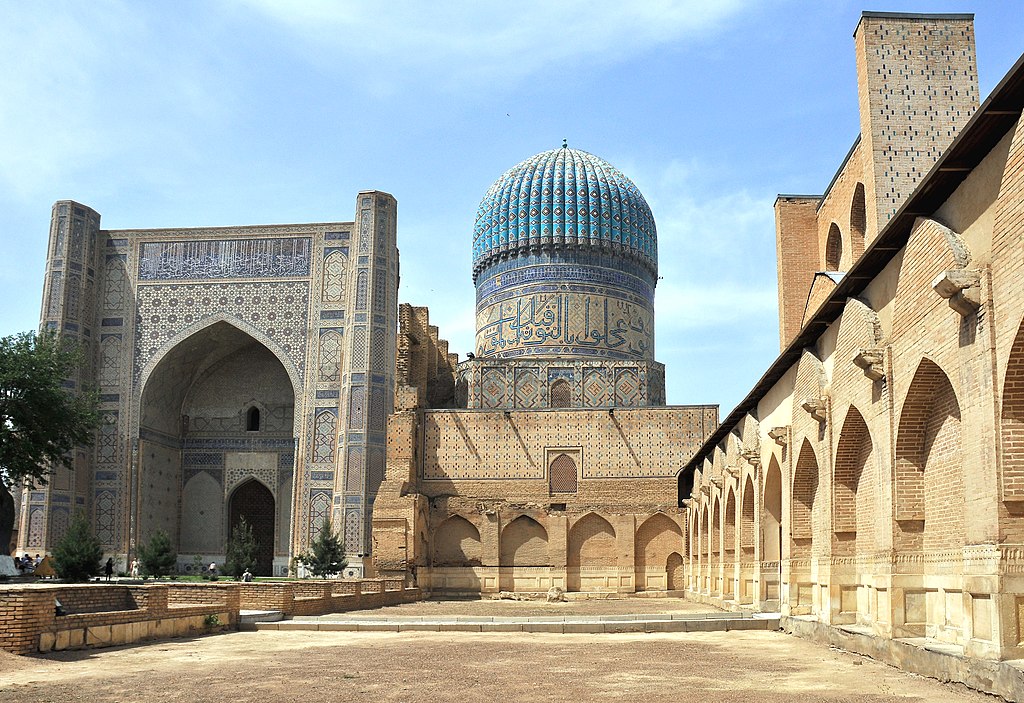
Timur himself commissioned the construction of the Bibi-Khanym Mosque to legitimize Samarkand as a powerful Islamic City. Construction began in 1399 and impressively, it only took the builders a few years to complete the job with most of the work being done by 1404. The mosque is known for its two monumental archways that are spaced over 300 feet apart. Today it’s part of a large UNESCO World Heritage Site known as, “Samarkand – Crossroad of Cultures.”
4. Shah-i-Zinda – Samarkand, Uzbekistan
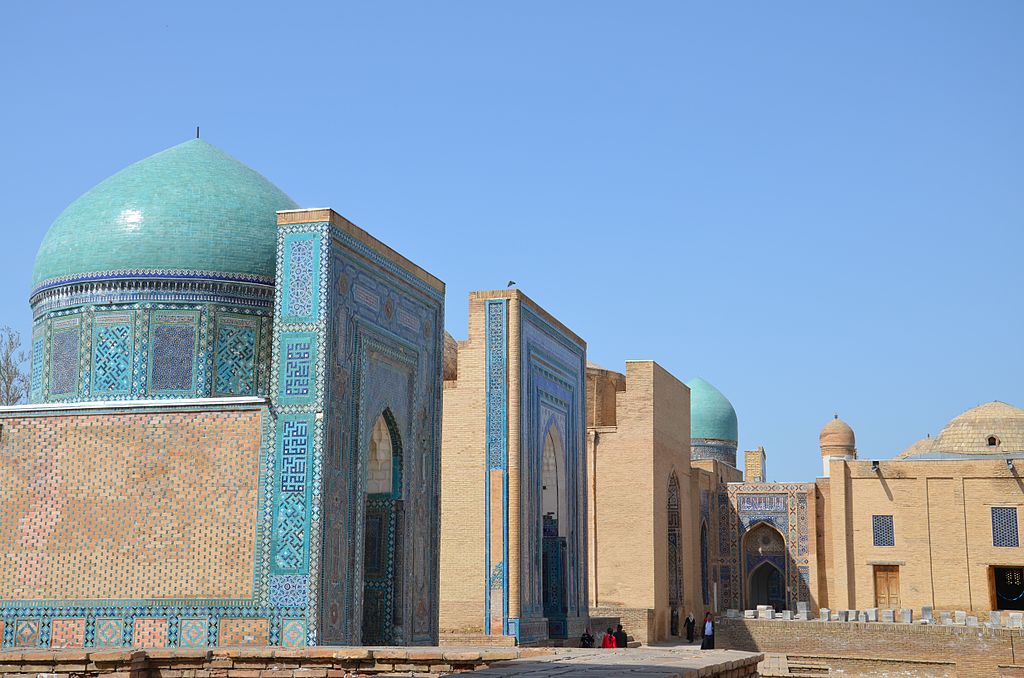
The Shah-i-Zinda is a necropolis located in Samarkand that was founded in the 11th century and was given its current appearance during the Timurid Renaissance. There are over ten different mausoleums, each of them orientated along a central avenue. Each mausoleum is unique, but they all showcase different elements of Timurid Architecture. The tombs feature several different styles of domes and some of the most ornate tile work found in any of the sites in Samarkand.
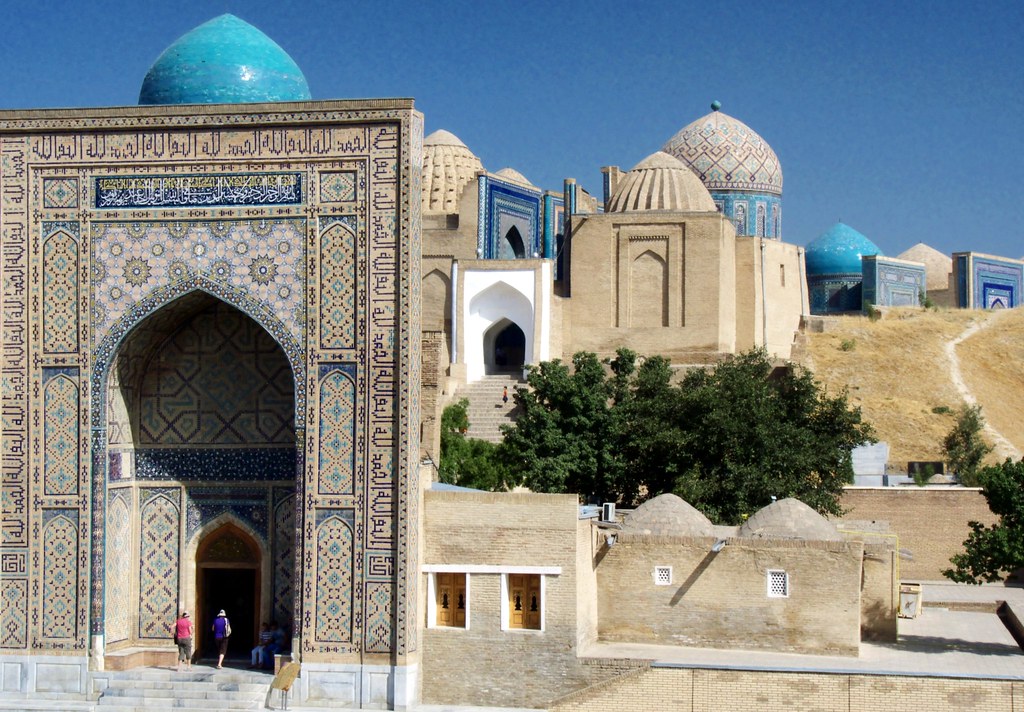
Shah-i-Zinda is also a very important site to Muslims because according to legend, a cousin of the great Prophet Muhammad is buried here. He traveled to Samarkand to preach Islam and he is responsible for the initial spread of the religion in the city. Today the site remains one of the most visited in all of Samarkand, and the buildings have been heavily restored in recent decades. Although often controversial, the government in Samarkand has spent millions preserving and repairing the city’s monuments. However, some experts question if the work is being done in a way that changes the look from the original Timurid-era designs.
Like Architecture of Cities? Sign up for our mailing list to get updates on our latest articles and other information related to Architectural History.
5. Blue Mosque of Maraz-i-Sharif – Mazaz-i-Sharif, Afghanistan
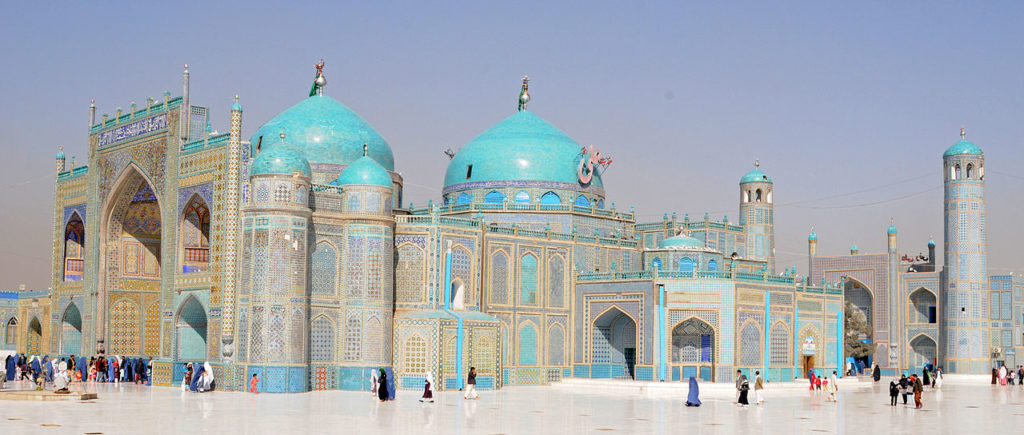
Today Maraz-i-Sharif is the fourth largest city in Afghanistan, and it was a prominent city in the Timurid Empire back in the 15th century. The Blue Mosque of Maraz-i-Sharif was completed in the year 1481, under the rule of Husayn Bayqarah Mirza, who ruled over the region from his capital in Herat. The mosque was designed in a typical form of Timurid Architecture, with all of the major elements. However, one thing that separates this mosque apart is the intensity of its colors. There are deep reds and yellow tones around the main entrance, and much of the blue tiles in the domes are a vivid shade of light blue. Although much of the tilework isn’t original thanks to frequent restoration projects, the overall style of the building greatly resembles the original Timurid-Era building.
6. Gur-e-Amir (Timur’s Mausoleum) – Samarkand, Uzbekistan
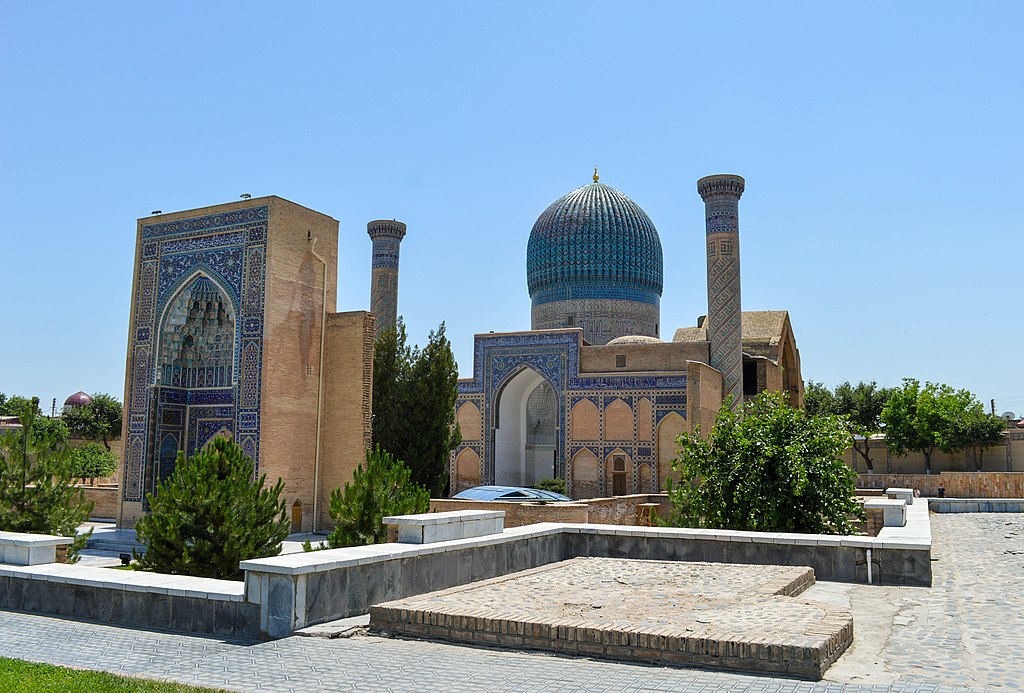
Timur, like many great conquerors before him, had his remains placed within a massive mausoleum complex in the center of Samarkand. His tomb remained relatively untouched for centuries until Joseph Stalin ordered that it be opened in the year 1941. Legend has it, that the tomb of Timur was cursed. There was a warning written within the tomb that read whoever disturbed the great Timur would unleash a conquerer far more fearsome than himself – and immediately after the Soviets opened the tomb, Hitler’s army crossed the border into Russia, on their way to Moscow. Legends aside, the Gur-e-Amir is still an incredible example of Timurid Architecture that is still frequently visited today.
7. Great Mosque of Herat – Herat, Afghanistan

Herat is the third-largest city in Afghanistan, and it was the capital of the Timurid Empire from 1405-1507. The city prospered throughout the span of the Timurid Dynasty and continued to be an important part of Safavid Persia after that. Although it was established in the 1200s, long before the arrival of Timur, much of the Great Mosque of Herat was built during the time of the Timurid Empire. The entire complex features many of the key features of Timurid Architecture such as geometric tilework. Unfortunately, much of the Mosque of Herat was destroyed during various armed conflicts within the region. An intensive reconstruction project has been underway since the 1940s, and although most of the tiles we see today are not original, they all follow the same Timurid-Era patterns and color schemes from the original building.
8. Ak-Saray (Timur’s Summer Palace) – Shahrisabz, Uzbekistan

One of the oldest examples of Timurid Architecture on this list is Timur’s Summer Palace, also known as Ak-Saray. Timur grew up in the city of Shahrisabz, and naturally, he wanted to spend his summers there, in a lavish palace built on the spoils of his conquests. Construction began on the massive project in 1380, and it was designed to be one of the grandest buildings in the entire Timurid Empire. Over time, earthquakes, erosion, and other elements have taken their toll on the building, and only a small fraction of it remains. Even though the archway has collapsed, the old monumental entrance of the palace still personifies just how impressive the original building was.
9. Kok Gumbaz Mosque – Shahrisabz, Uzbekistan
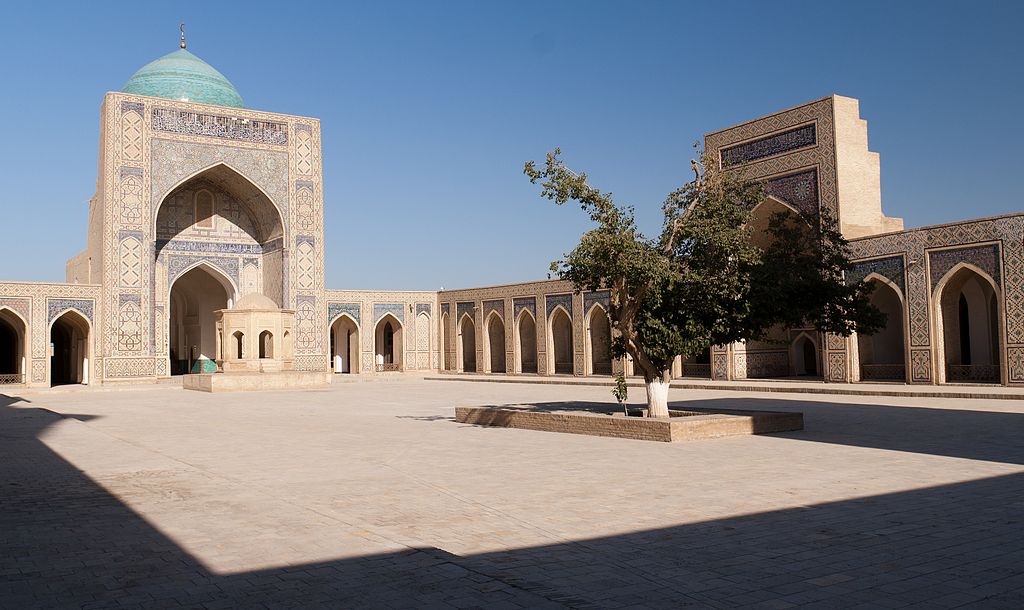
Located not far from Timur’s Summer Palace, is the main mosque of Shahrisabz, the Kok Gumbaz Mosque. It was completed in 1436, during a time when Shar Rukh ruled the empire. The mosque is set around a large central courtyard, which is surrounded by a colonnade of pointed Islamic Arches. At each of the four walls of the courtyard, there is a large facade decorated with ornate blue tilework. Today the Kok Gumbaz Mosque is grouped together with several other monuments to form a UNESCO World Heritage Site known as the Historic Center of Shahrisabz.
10. Citadel of Herat – Herat, Afghanistan
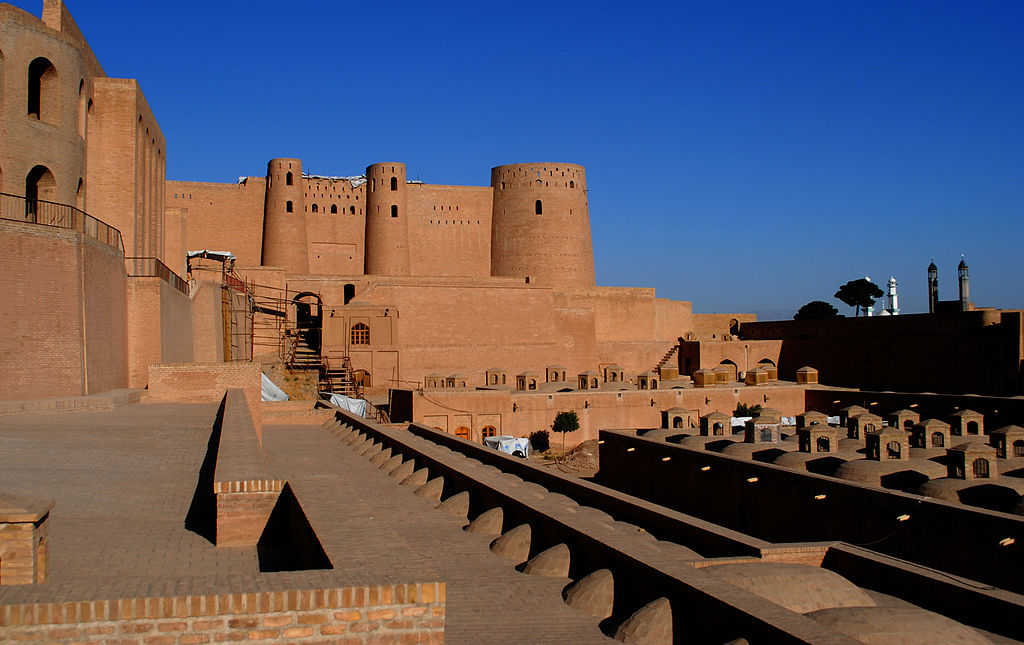
Herat was the capital of the Timurid Empire for over a century, and the Timurids made great use of the existing fortifications within the city. The Citadel of Herat stood as the city’s main fortification since the 3rd century BCE, making it over 2,200 years old. Although the citadel doesn’t really contain the typical features of Timurid Architecture like many other buildings on this list, it is still a great example of a Central-Asian-Style fortification from this time period. Much of the cities throughout the land of the Timurid Empire would have had similar defenses as Herat.
11. Ulugh Beg Observatory – Samarkand, Uzbekistan
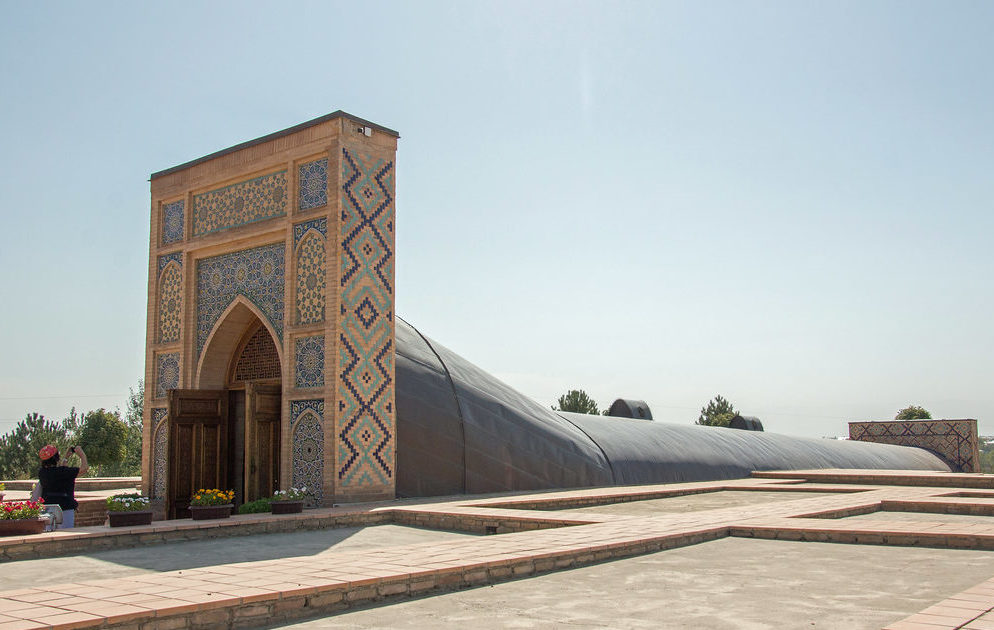
Ulugh Beg was one of the greatest rulers of the Timurid Empire, although he only ruled for a short time from 1447-1449. He also served as a provincial governor before his time as Sultan, and that is when he oversaw the construction of the Ulugh Beg Observatory in 1424-1429. He is known for his own personal achievements in the fields of Astronomy and Mathematics, and he wanted to use the observatory to learn more about the sun, stars, and planets. Although it’s not as massive and impressive as some of the other works of Timurid Architecture on this list, the Ulugh Beg Observatory shows how intellectual thinking was an important part of Timurid Culture, and this thirst for knowledge was a key idea within the Timurid Renaissance.
12. Gawhar Shad Mausoleum – Herat, Afghanistan
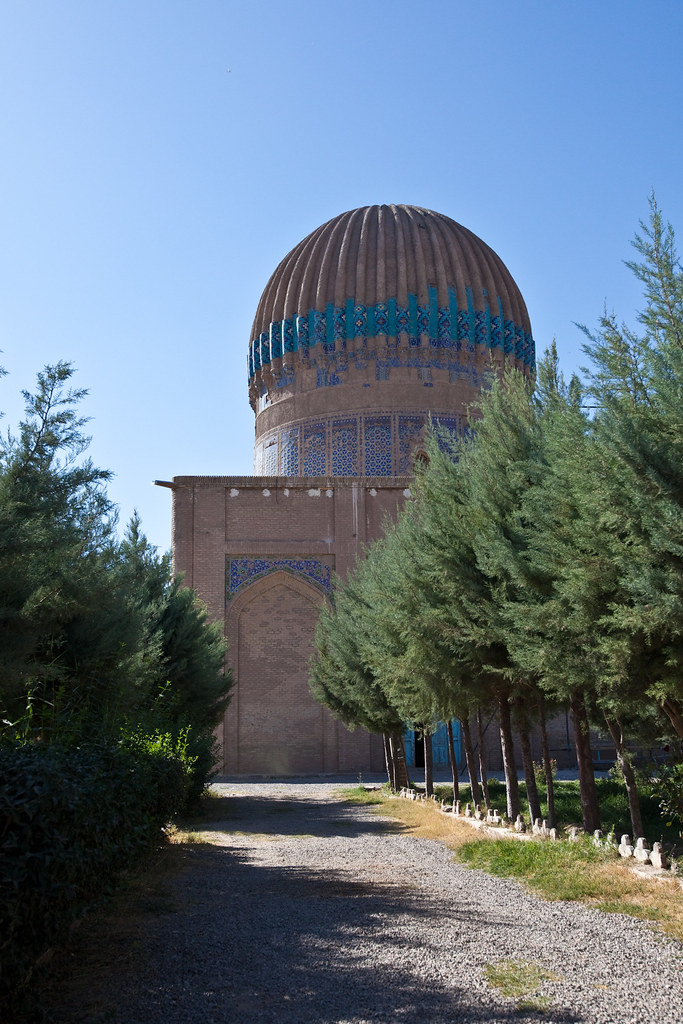
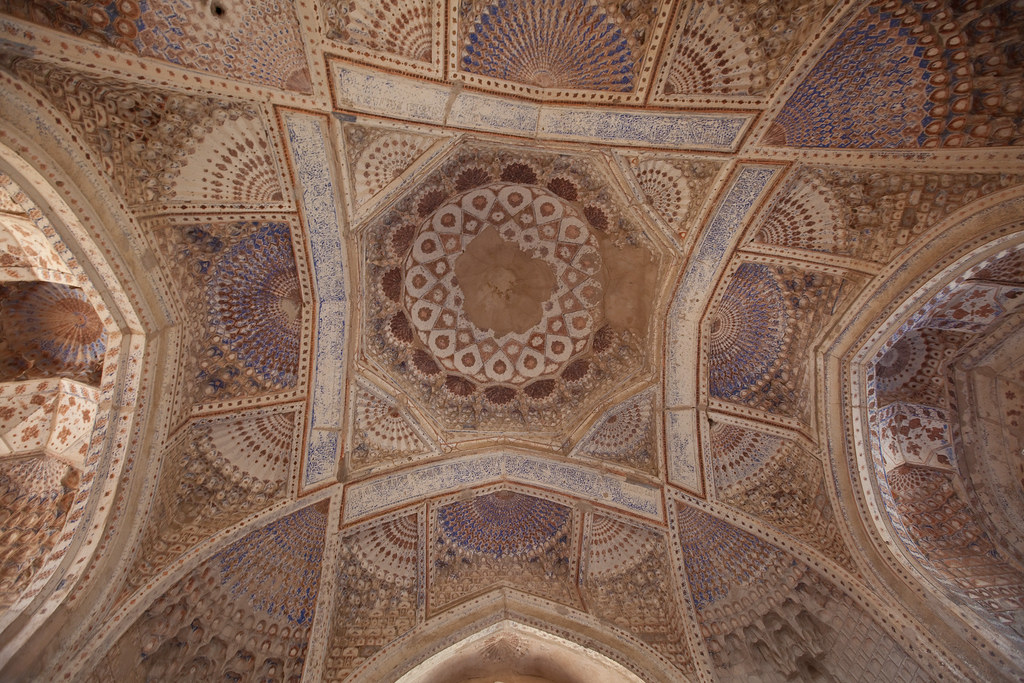
One of several works of Timurid Architecture located in Herat Afghanistan, the Gawhar Shad Mausoleum was constructed in 1438, during the reign of Shah Rukh. Shah Rukh was one of the longest-reigning rulers of the Timurid Empire. He was in power from 1405-1447. It was his decision to move the capital from Samarkand to Herat, which was a more centralized location within the empire. The bulbous dome with the fluted sides is a typical element in Timurid architecture, and the interior ceiling is filled with intricate geometry and muqarnas, which are typical features in Islamic Architecture.
13. Bibi-Khanym Mausoleum – Samarkand – Uzbekistan
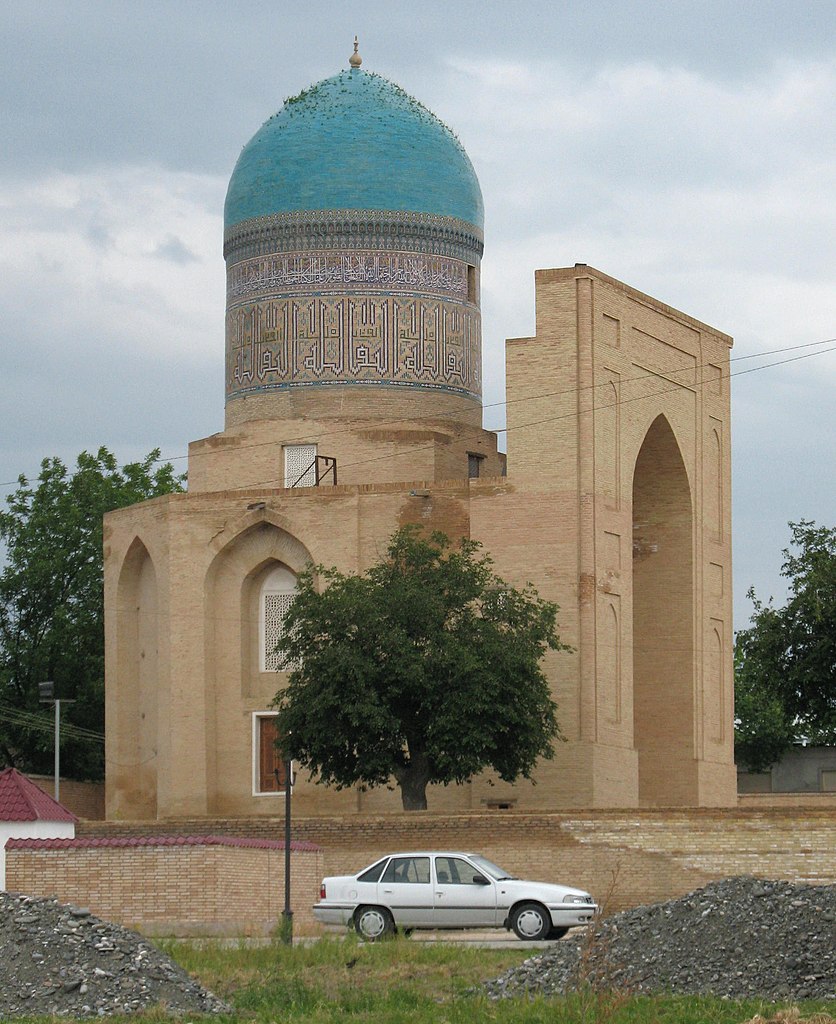
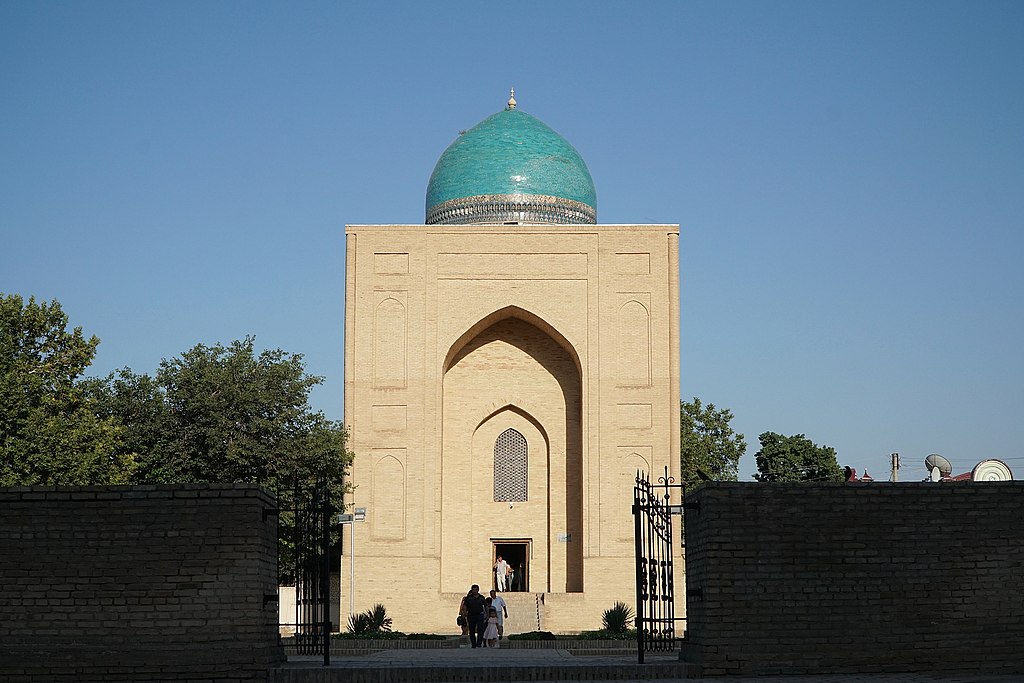
right Photo by Adam Harangozó from Wikimedia Commons
Located just across the road from the Bibi-Khanym Mosque (#3 above), the Bibi-Khanym Mausoleum is another historic work of Timurid Architecture in Samarkand. Both the mausoleum and the mosque of Bibi-Khanym were left in a state of disrepair by the start of the 20th century. The frequent earthquakes in the region, combined with regular erosion damaged parts of the domes and the monumental entrances on many Timurid-Era Buildings. During the period of Soviet Influence in this part of Asia, many huge restoration projects were undertaken in Samarkand, and now many of the city’s buildings are in pristine condition.
14. Goharshad Mosque – Mashhad, Iran
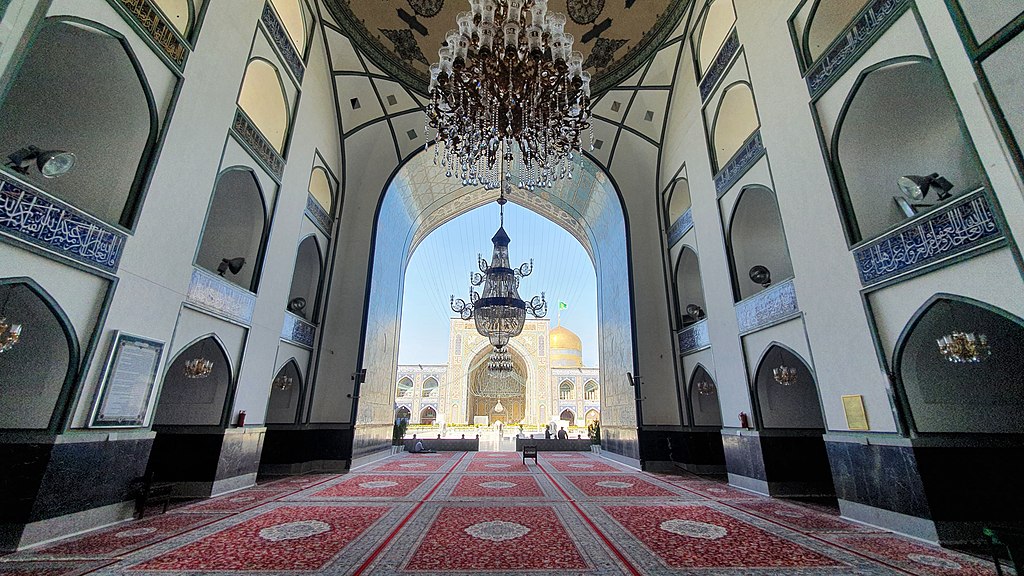
Mashad was an important city in the heart of the Timurid Empir and It was located about 225 miles (365 km) to the northeast of the empire’s capital Herat. Today Mashad lies within the borders of Iran, making the Goharshad Mosque one of a few major Timurid Buildings within the nation. Construction began on the mosque in 1418, during the reign of Shah Rukh. It highlights many of the important features of Timurid Architecture such as the Monumental Entrances and the multi-colored tilework. These elements are present in Persian Architecture from both before and after the time of the Timurid Empire.
15. Ruins of the Musalla Complex – Herat, Afghanistan

The Musalla Complex was once a mighty group of buildings located in the city of Herat, Afghanistan. It was an impressive example of Timurid Architecture, and at one point in time contained impressive tile work, domes, and grand arches. But today, only four minarets remain on the edge of the overall compound. Even though it’s essentially in ruins, the Musalla Complex still shows the power and influence of the Timurid Empire. The large building footprint shows how the emperors were building massive structures in their capital Herat, ushering in an age of learning, innovation, and impressive architecture.
The Timurid Renaissance
So far this article has highlighted some of the most impressive examples of Timurid Architecture from the time of the Timurid Empire, but the empire created so much more than just buildings during its lifetime. Although short-lived when compared to many other nations, the Timurid Empire reached new heights in the fields of art, science, astronomy, and mathematics. All of these innovations had a huge impact on the development of Central Asia. Because this time period has so many similarities to the European Renaissance Movement that started in Florence, many historians have dubbed it, “The Timurid Renaissance.”
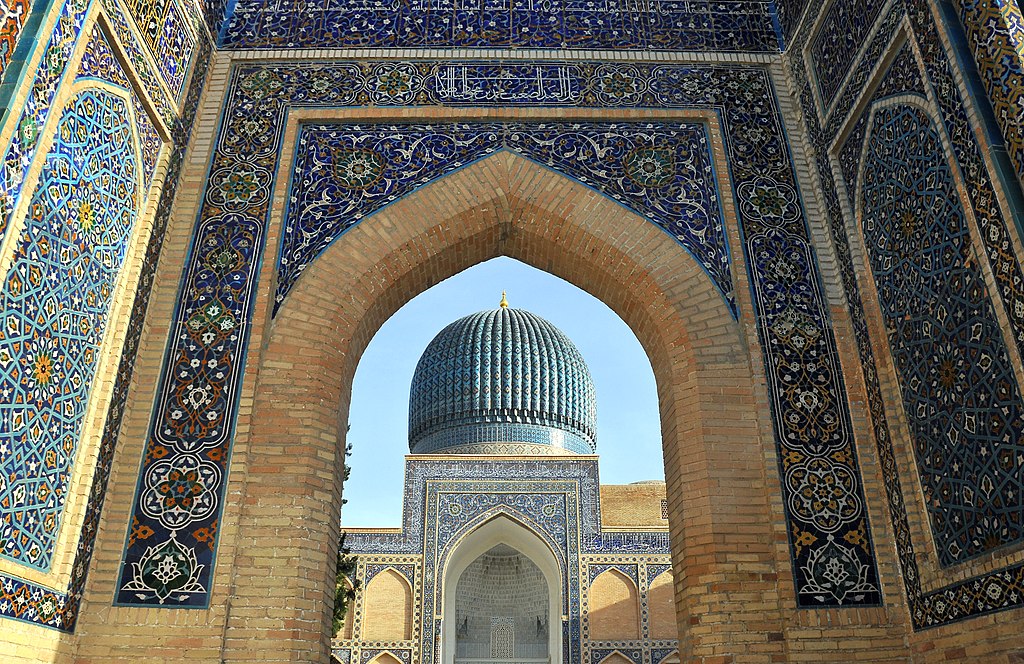
In addition to all the incredible artwork in the buildings listed above, the craftsmen in the Timurid Empire created magnificent illustrations. Both of the images below date from the 15th century golden age of the empire. The left image is a depiction of laborers constructing a defensive fort, using wooden scaffolding. The right image dates from 1432 and shows a typical Timurid-Era building, complete with all of the ornate tilework found throughout Timurid Architecture.
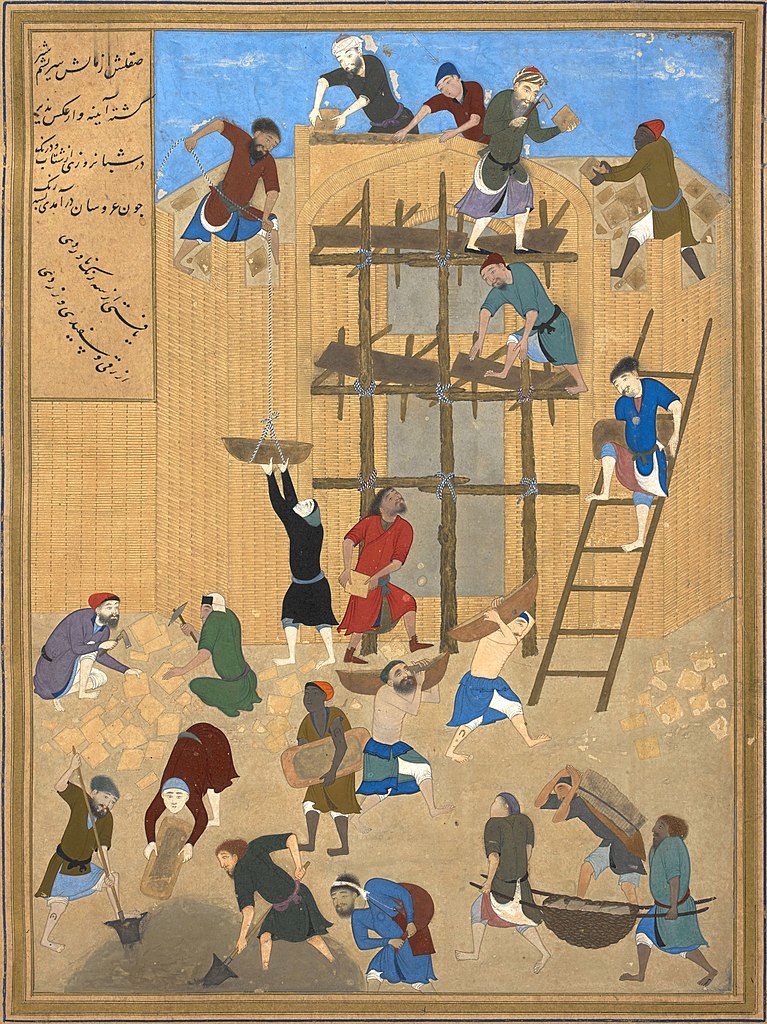

Developments in science, astronomy, and mathematics were also key elements in the Timurid Renaissance. Jamshīd al-Kāshī was a brilliant mathematician who lived from 1380-1429. Emperor Shah Rukh was a major patron of his studies. Jamshīd al-Kāshī developed new theories in trigonometry, which eventually lead to the mathematical Law of Cosines. The Sullam al-sama’ was an important astronomical text that was written by the astronomer Jamshid Kashani in 1407. It helped people learn the relative locations of astronomical bodies such as the sun, moon, and other planets in relation to the Earth.
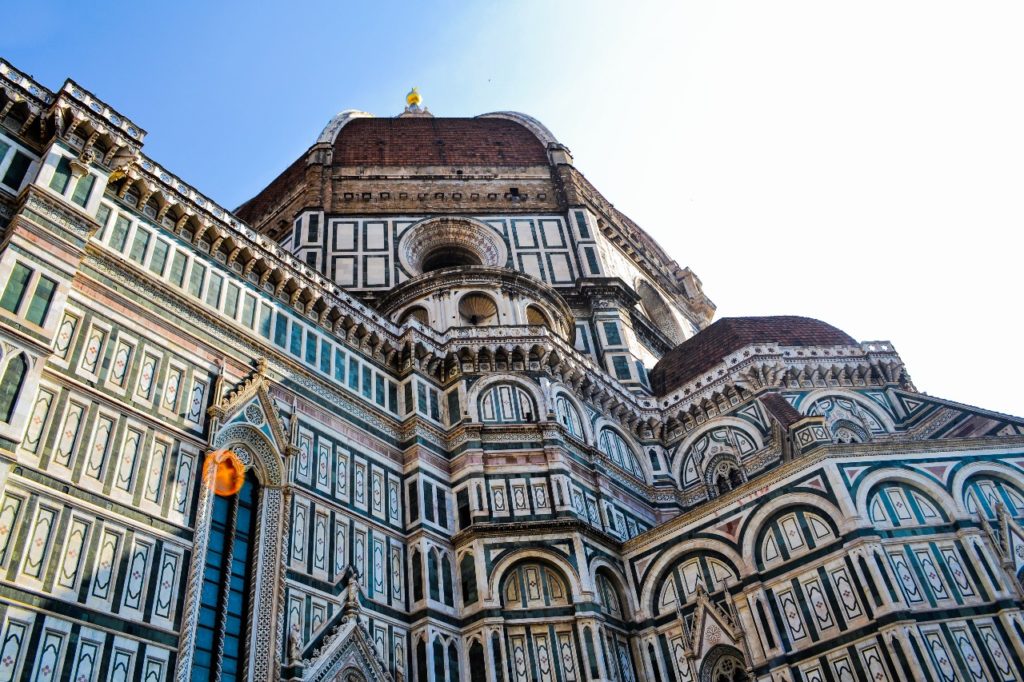
Interested in Renaissance Architecture? Check out our article on the Architecture of Florence to learn more about the birth of the Renaissance Movement.
Influence of Timurid Architecture
Timurid Architecture remains a relevant building form to this day and many modern projects in Uzbekistan attempt to call back to the glory days of the former Timurid Empire. The Hazrat Imam Mosque is a great example of this. It is a work of 21st-century architecture, and it officially opened to the public in 2007. It was built within the city of Taskent, the modern capital of Uzbekistan, which is today the most populous city in all of Central Asia. The builders deliberately borrowed all of the textbook elements of Timurid Architecture including the domes, the blue tile work, and the monumental entrance at the front of the mosque.
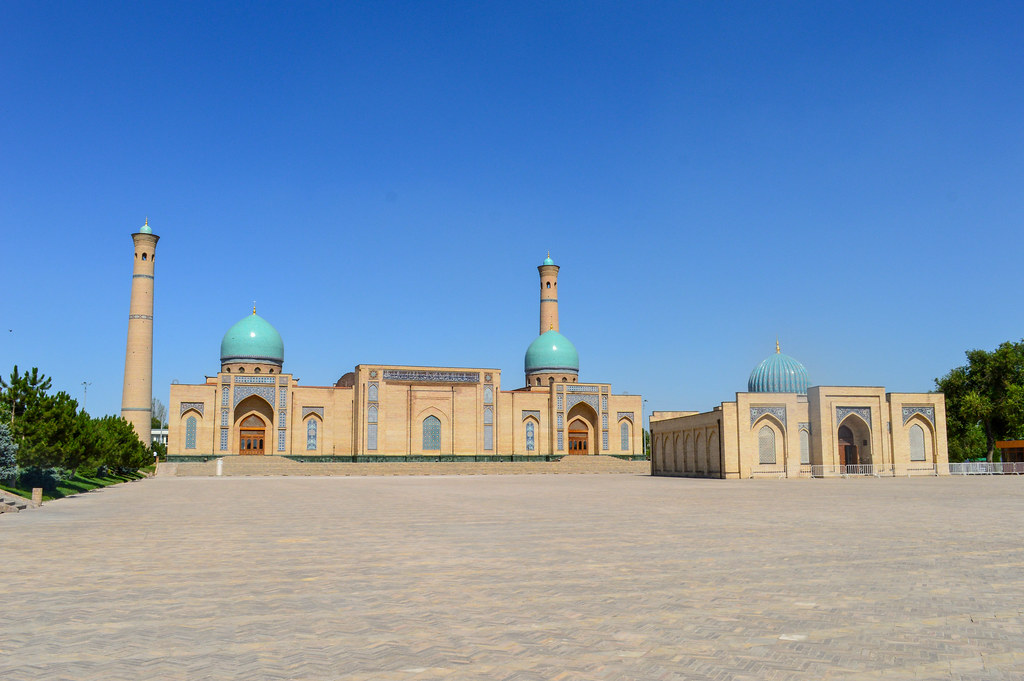
Photo by Francisco Anzola from flickr
Located in the same square as the Harat Imam Mosque, the Barakhan Madrasah is another modern work of Timurid Architecture located in Tashkent. This cluster of Timurid Style buildings is fastly growing into one of the most visited attractions within the city. It’s easy to see why visitors love these monuments, and it really seems as if they are replicating a similar feel to the mighty Registan of Samarkand. You can check out this Photo Sphere to see exactly how the monuments are orientated amongst one another.
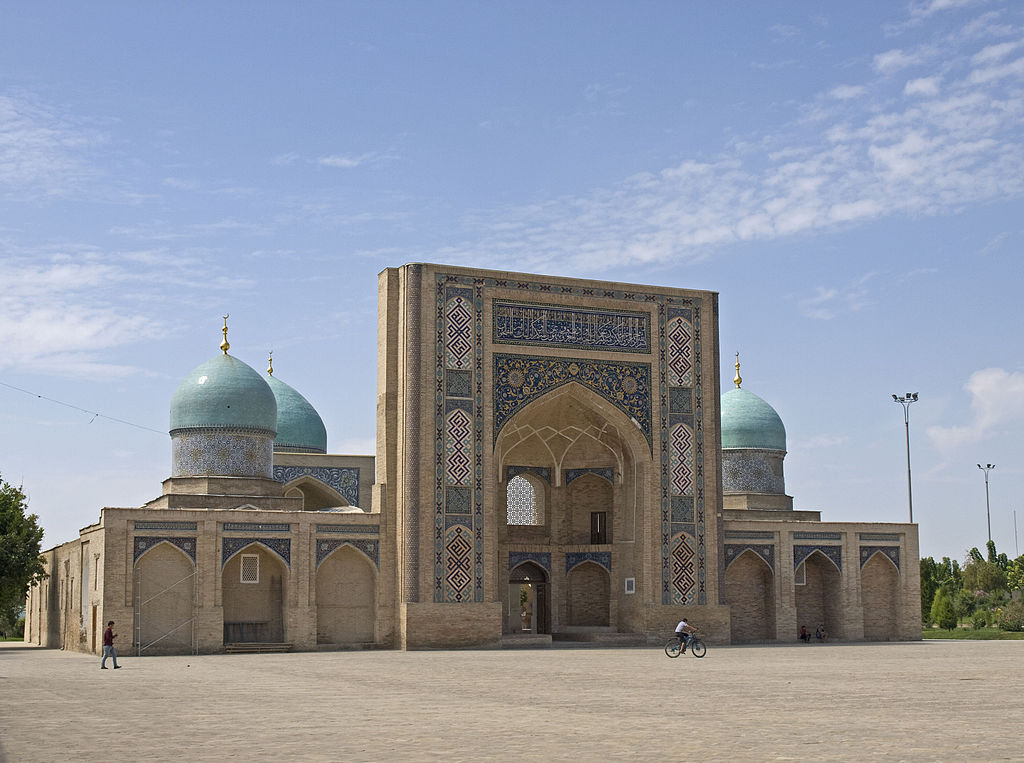
Photo by Ymblanter from Wikimedia Commons
The mausoleum of Imam al-Bukhari is another example of a modern building that is designed in the Timurid Style. Imam al-Bukhari was a famous Islamic Scholar who lived during the 9th century. His tomb is located at the heart of the building, within the shrine at the center of the photo below. The shrine was built during the Timurid era in the 1500s, but the surrounding structure is from a massive rebuilding project, completed in 1998.

Photo by Farsizabon from Wikimedia Commons

Interested in Istanbul? Check out our article on the Architecture of Istanbul to learn more about the city’s historic buildings!
Timurid Architecture Today
Today Timurid Architecture remains as relevant as it was 5 centuries ago. Many of the monuments of the Timurid Empire are still regarded as some of the finest buildings within the modern nations of Uzbekistan, Afghanistan, Kazakhstan, and Iran. Although Timur and his descendants were only able to hang on to their empire for a short time, they left behind a legacy that has lasted until the modern age. The legacy of Timur, the Timurid Empire, and the Timurid Renaissance all remain prevalent in the overall culture and heritage of modern-day Uzbekistan.

- About the Author
- Rob Carney, the founder and lead writer for Architecture of Cities has been studying the history of architecture for over 15 years.
- He is an avid traveler and photographer, and he is passionate about buildings and building history.
- Rob has a B.S. and a Master’s degree in Architecture and has worked as an architect and engineer in the Boston area for 10 years.
Like Architecture of Cities? Sign up for our mailing list to get updates on our latest articles and other information related to Architectural History.
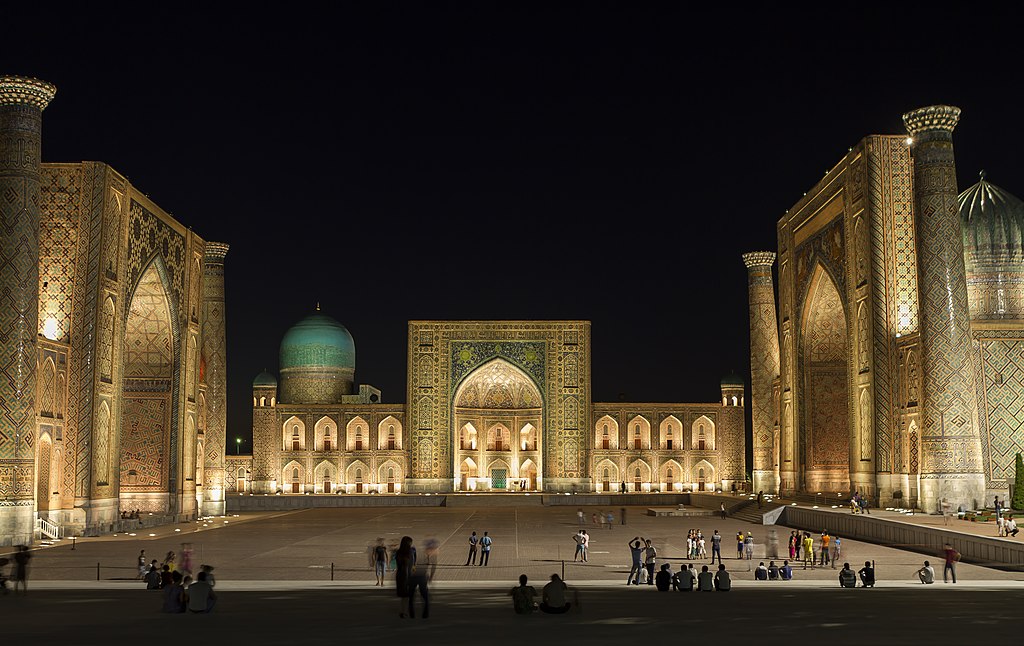
Photo by Benjamin Goetzinger from Wikimedia Commons
